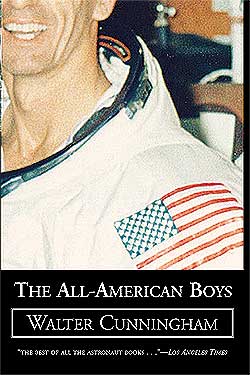|
The Flight Of The Phoenix
The rocket rises from the pad so slowly, so ponderously at first, that you could be imagining it even moved at all. It is an agonizingly slow ten seconds before Apollo 7 clears the tower. One million three hundred thousand pounds is balancing on an arrow of flame. Painstakingly, it climbs, trailing a fireball as vivid as the colors of hell. At the spectator bleachers, two-and-one-half miles away, the earth actually trembles. The vibrations, the noise, the shock; they roll over you in waves. And, from out of the second fire on Pad 34 rises our modern-day Phoenix. I'd seen many lift-offs, but this one was different: It was the largest rocket ever launched carrying the largest payload ever placed in orbit. And, oh yeah, this time I was riding inside, not watching. Half a million Americans lined the the roads and beaches of Florida that day to watch the United States re-enter the world of manned space flight. It isn't stretching the truth or over-dramatizing to say we carried the nation's hopes with us. Twenty-one months before, a fire on the very pad from which we launched had killed three good friends. Another setback now, and our prospects of landing a man on the moon before 1970 will be lost forever. In the cabin we have no way of sensing the actual moment of lift-off. We know our Phoenix has begun its climb from out of the fireball only because the spacecraft clock begins ticking off the elapsed time and Wally can see the altimeter climbing. Inert metal and fuel has turned into a live monster. Once quiet dials beginning to move and jump. Donn has the G&N computer flashing our trajectory parameters. I am monitoring the environmental and electrical systems to insure that the cabin pressure is bleeding down according to schedule to prevent a blowup in the vacuum of space. It is the most complex machine ever built by man to be operated by man. And our job is to see that the monster does not eat us alive. Our first order of business on waking up (naturally) was to play Pass the Urine Bag (technically the UCD, or Urine Collection Device). After it was filled, a series of valves permitted us to dump the contents of the bag overboard. Now, that was something worth taking a picture of. If one dumped just at sunset, the flecks of ice coming off the urine dump nozzle would look like a million stars and it would be impossible to take star sightings for about five minutes. Of course, it's a real experience to see your own urine take on a cosmic quality in space. But it is eye-catching and every crew has taken pictures of it. The ice particles are quite beautiful, the very phenomenon that caused John Glenn to rave about the "fireflies" at sunset. It was considered a mystery at the time of the first reports, and I don't think space officials ever released a clear explanation. Believe me, just doing it was no simple process. A modified condom was attached to one's penis and a storage bag was filled through a valving system. After the bag was dumped overboard, we allowed it to drain for a while to insure all the moisture was out of the system. We were forever forgetting to close the overboard dump valve, and it would eventually bleed down the pressure in the spacecraft enough to trigger an alarm, indicating an air leak. After several days' use, this alarm came to mean simply that the last one at the john had left the urine dump valve open. When time was short, it was possible to urinate straight through the system, but with a perfect vacuum at one end of the hose and an essential part of one's anatomy on the other, we tended to be a mite careful in manipulating the valves.
Here is probably as good a place as any to answer the
other half of the second or third most popular space question. It was the solid
waste management problem that we all dreaded. Before Apollo, most missions were less than
four days in duration and it was possible to go on a low residue diet and avoid the
problem entirely. On Apollo 7, we made it to the third day before anyone had to answer the
call of nature. Following my first experience, I wrote the following memo on my logbook to
help follow-on crews preparing for their maiden voyage.
Order a Signed & Inscribed Copy
via mail order |
